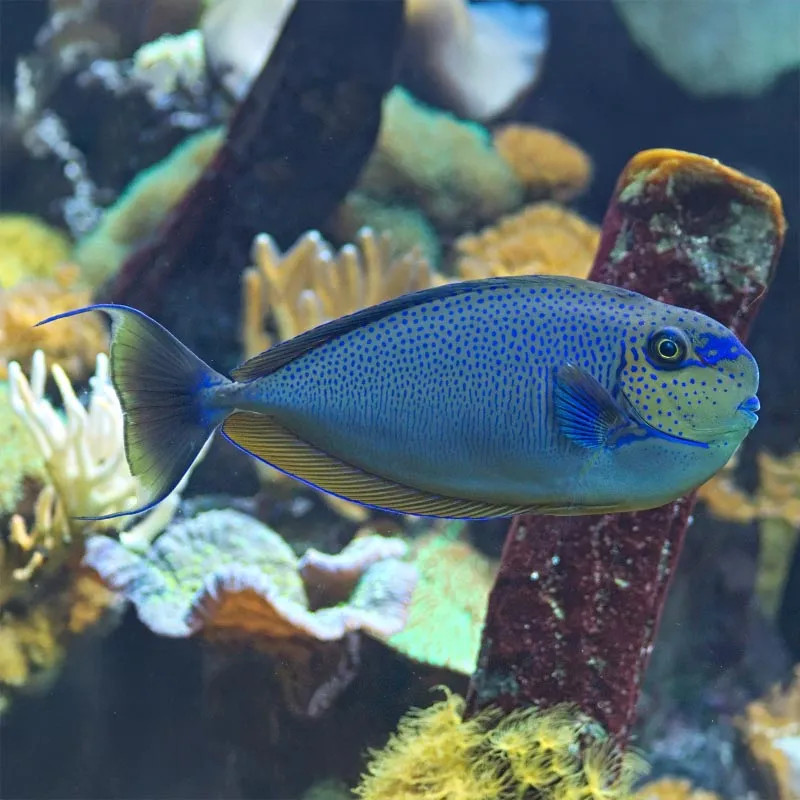Stocks Available
Powder blue tang
SKU:215690
ACANTHURUS LEUCOSTERNON
3-4 INCH

Stock Available
Introduction: • Common Name: Vlamingii Tang • Native Habitat: Found in the warm waters of the Indo-Pacific region, particularly around coral reefs and lagoons, commonly observed in places like the Great Barrier Reef and the Red Sea. Physical Characteristics: • Appearance: The Vlamingii Tang features a unique, elongated body with a striking coloration that includes a bluish-gray body accented by vibrant yellow and orange markings. Its dorsal fin is long and sail-like, contributing to its graceful swimming style. • Size: Can grow up to 12 inches (30 cm) in length. • Fins: Characterized by a prominent, pointed snout and a distinctive tail spine, which can be used for defense. Habitat Requirements: • Tank Size: A minimum tank size of 180 gallons is recommended to accommodate its active swimming behavior and territorial nature. • Water Conditions: • Temperature: Optimal temperature range is between 75°F and 82°F (24°C to 28°C). • pH Level: Ideal pH is between 8.1 and 8.4. • Salinity: Maintain a salinity of 1.020 to 1.025 for optimal health. • Aquascaping: Provide plenty of hiding spots with live rock, caves, and open swimming spaces to create a stimulating environment. Diet: • Feeding Habits: Vlamingii Tangs are primarily herbivorous, relying on algae and plant material in their diet. • Dietary Options: They benefit from a varied diet that includes high-quality marine algae, spirulina, and herbivore pellets. Fresh greens like spinach and nori can also be offered. • Feeding Frequency: Feed small amounts multiple times a day to ensure they receive adequate nutrition and to keep their digestive system healthy. Compatibility: • Temperament: Generally peaceful but can become territorial, especially in smaller tanks or when breeding. • Tank Mates: Compatible with larger, peaceful fish such as tangs, wrasses, and angelfish. • Incompatibilities: Avoid keeping them with smaller, more timid species or other tangs to prevent aggressive interactions. Care Level: • Difficulty: Moderate; while they are hardy fish, they require stable water conditions and a proper diet to thrive. • Health Monitoring: Regular water quality testing and monitoring for signs of stress or disease are essential. Breeding: • Breeding Behavior: Breeding in captivity has not been successfully documented; in the wild, they are known to form schools, especially during the spawning season. • Fry Care: Specialized care would be required for fry if breeding were to occur. Economic Considerations: • Market Demand: Vlamingii Tangs are sought after by marine aquarium enthusiasts due to their striking appearance and lively behavior. • Pricing: Pricing can vary based on size and availability, typically falling within the moderate to high range. Sustainability and Conservation: • Wild Population: Currently not endangered, but habitat degradation and overfishing remain concerns in some areas. • Aquaculture: Limited success in captive breeding, with many specimens still sourced from the wild. Conclusion: The Vlamingii Tang is a beautiful and dynamic species that adds color and activity to marine aquariums. With the right care, a spacious tank, and compatible tank mates, these tangs can thrive and become a centerpiece in any underwater setting.
Data sheet
16 other products in the same category:
Customers who bought this product also bought: